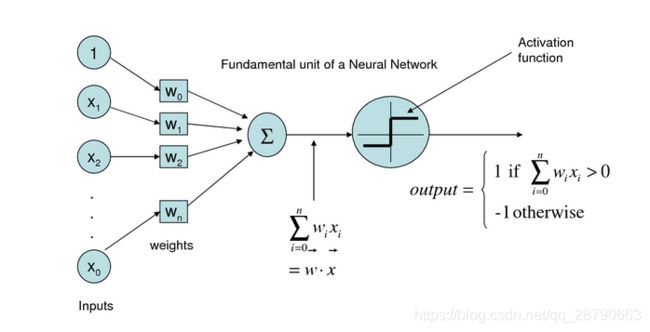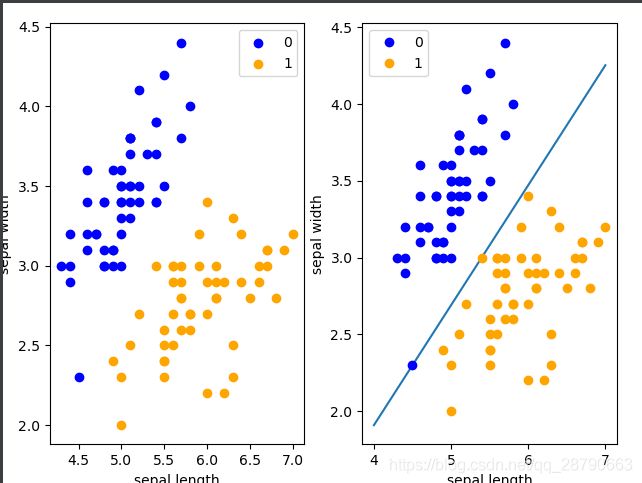感知机算法原理与多种python实现方式结果可视化
感知机(perceptron)算法
二分类模型、线性分类模型、判别模型
感知机(perceptron)是根据输入数据的特征向量x,对其进行二分类的一种线性分类模型。
感知机的输出与输出:
| 输入(input) | 输出(output) |
| 实例的特征向量 | 实例的类别(取值为+1或-1) |
感知机是一个分类器,对于输入空间内的实例划分为正负两类超平面,属于判别模型!(比如:有两组数据作为训练集,其中的类别是A和B,在训练完成后,通过给定一个测试数据,感知器能够将其分成A或者B)
感知机模型
感知机模型实际上是一个超平面:
![]()
其中![]() ,
,![]() ,
,![]()
当![]() 时,模型将该样本分为正类
时,模型将该样本分为正类
当![]() 时,模型将该样本分为负类
时,模型将该样本分为负类
(图中有错误,最下面的![]() 应该是
应该是![]() )
)
感知器包括多个输入节点,从![]() 到
到![]() ,有多个权重矩阵
,有多个权重矩阵![]() 到
到![]() 。一个输出节点O,激活函数使用sigh函数,最后输出的值为1或者-1
。一个输出节点O,激活函数使用sigh函数,最后输出的值为1或者-1
学习策略:
令 M 代表样本点被误分的集合。
所有的被误分类的点都满足:![]()
优化目标是损失最小化,含义为:最小化误分类点到决策面的距离!
学习算法(优化算法)
随机梯度下降算法(stochastic gradient descent)——每次选取一个被误分类的点,计算损失函数并进行参数更新。
计算梯度:
参数更新:
即:
感知器学习规则
输入训练样本X和初始的权重矩阵W,将其进行向量的点乘,按后将求和的结果作用于激活函数sigh(),得到预测输出O,根据预测输出值和目标之间的差距error来调整权重向量W。如此反复,直到W调整到合适的结果。
使用python手动实现感知器模型:
数据集:sklearn中的鸢尾花(iris)数据集
相关任务:分类
实例的个数:150个
特征的个数:4个
有无缺失值:无
Abstract: Famous database; from Fisher, 1936
数据集介绍:iris数据集是由Fisher在1936年整理,包含四个特征:
Speal.Length(花萼长度)
Speal.Width(花萼宽度)
Petal.Length(花瓣长度)
Petal.Width(花瓣宽度)
四个特征的类型都为浮点型,单位是厘米。
类别共有三类:
Iris Setosa(山鸢尾)
Iris Versicolour(杂色鸢尾)
Iris Virginica(维吉尼亚鸢尾)
第一个实验Sklearn的Iris数据集拿出两个类别,并以[Speal.Length,Speal.Width]做为特征:
import numpy as np
import pandas as pd
import matplotlib.pyplot as plt
from sklearn.datasets import load_iris
def display(df,x_points,y_):
fig = plt.figure()
ax1= fig.add_subplot(1,2,1)
ax2 = fig.add_subplot(1,2,2)
fig.tight_layout() # 设置默认的间距
#选取1-50作为第一类,50-100作为第二类
ax1.scatter(df[:50]['sepal length'],df[:50]['sepal width'],color='blue',label='0')
ax1.scatter(df[50:100]['sepal length'],df[50:100]['sepal width'],color='orange',label='1')
ax1.set_xlabel('sepal length')
ax1.set_ylabel('sepal width')
ax1.legend()
#可视化展示
ax2.plot(x_points, y_)
ax2.scatter(df[:50]['sepal length'],df[:50]['sepal width'], color='blue', label='0')
ax2.scatter(df[50:100]['sepal length'],df[50:100]['sepal width'] , color='orange', label='1')
ax2.set_xlabel('sepal length')
ax2.set_ylabel('sepal width')
ax2.legend()
fig.show()
def load_data():
# 加载iris数据集
iris = load_iris()
# 转换成df格式,然后将列名设置为对应的标签名
df = pd.DataFrame(iris.data, columns=iris.feature_names)
df['label'] = iris.target
df.columns = ['sepal length', 'sepal width', 'petal length', 'petal width', 'label']
# 为了方便可视化,只使用sepal length 和 sepal width作为特征
return df
class Perceptron():
def __init__(self):
self.w = np.ones(len(data[0])-1 , dtype=np.float32)
self.b = 0
self.l_rate = 0.1
self.epoch = 1000
#定义符号函数
def sign(self,x,w,b):
y = np.dot(x, w) + b
return y
def fit(self,x_train,y_train):
error_count=0
for _ in range(self.epoch):
for i in range(len(x_train)):
xi = x_train[i]
yi = y_train[i]
#如果当前节点分类错误
if yi * self.sign(xi,self.w,self.b) <= 0:
self.w += self.l_rate * np.dot(xi,yi)
self.b += self.l_rate * yi
error_count += 1
# print('w='+str(self.w)+',b='+str(self.b))
if __name__ == '__main__':
df = load_data()
#选取前100个数据,选择的列为第0列,第1列,最后一列(标签)
data = np.array(df.iloc[:100,[0,1,-1]])
X,y = data[:,:-1],data[:,-1]
#对标签进行变换,由于感知机只能分类两类,输出值为1或-1,所以需要把0标签转换为-1
y = np.array([1 if label==1 else -1 for label in y])
perception =Perceptron()
perception.fit(X,y)
# 可视化超平面
x_points = np.linspace(4, 7, 10) # linspace返回固定间隔的数据
# 误差分类点到超平面的距离
y_ = -(perception.w[0] * x_points + perception.b) / perception.w[1]
display(df,x_points,y_)
接下来在红酒数据集上进行试验,不再进行可视化,而是使用多个评价指标进行试验:
"""
__author__:shuangrui Guo
__description__:
"""
import numpy as np
import pandas as pd
import matplotlib.pyplot as plt
from sklearn.linear_model import Perceptron
from sklearn.metrics import accuracy_score
from sklearn.metrics import f1_score
from sklearn.metrics import precision_score
from sklearn.metrics import recall_score
from sklearn.metrics import roc_auc_score
#加载红酒数据集
def load_wine_data(file_path):
labels = []
features = []
with open(file_path,'r',encoding='utf-8') as f:
for line in f.readlines():
content=line.strip().split(',')
labels.append(content[0])
features.append(list(map(float,content[1:])))
df = pd.DataFrame(features)
df.columns =['Alcohol','Malic acid','Ash','Alcalinity of ash','Magnesium','Total phenols','Flavanoids','Nonflavanoid phenols','Proanthocyanins','Color intensity','Hue','OD280/OD315 of diluted wines','Proline']
labels = pd.DataFrame(labels,columns=['label'])
data = pd.concat((df,labels),axis=1)
return data
if __name__ == '__main__':
wine_file_path = './wine.data'
data = load_wine_data(wine_file_path)
#取前130个数据(前130行数据包括两类)
features = np.array(data.iloc[:130,:])
X_train = np.concatenate([features[:49,:-1], features[60:120,:-1]], axis=0)
y_train = np.concatenate([features[:49,-1],features[60:120,-1]],axis=0)
y_train= np.array([1 if label =='1' else -1 for label in y_train])
#X_train,y_train = features[:59,:-1]+features[:,:-1],features[:59,-1]+features[:,-1]
X_test=np.concatenate([features[49:59,:-1], features[120:130,:-1]], axis=0)
y_test = np.concatenate([features[49:59,-1],features[120:130,-1]], axis=0)
y_test= np.array([1 if label =='1' else -1 for label in y_test])
perceptron = Perceptron(fit_intercept=False,max_iter=1000,shuffle=True)
perceptron.fit(X_train,y_train)
y_pre = perceptron.predict(X_test)
print('测试集准确率为:',accuracy_score(y_test,y_pre))
print('测试集的F1值为:',f1_score(y_test,y_pre))
print('测试集的precision_score为:',precision_score(y_test,y_pre))
print('测试集的recall_score为:',recall_score(y_test,y_pre))
print('测试集的roc_auc_score值为:', roc_auc_score(y_test, y_pre))
测试集准确率为: 0.95
测试集的F1值为: 0.9523809523809523
测试集的precision_score为: 0.9090909090909091
测试集的recall_score为: 1.0
测试集的roc_auc_score值为: 0.9500000000000001







